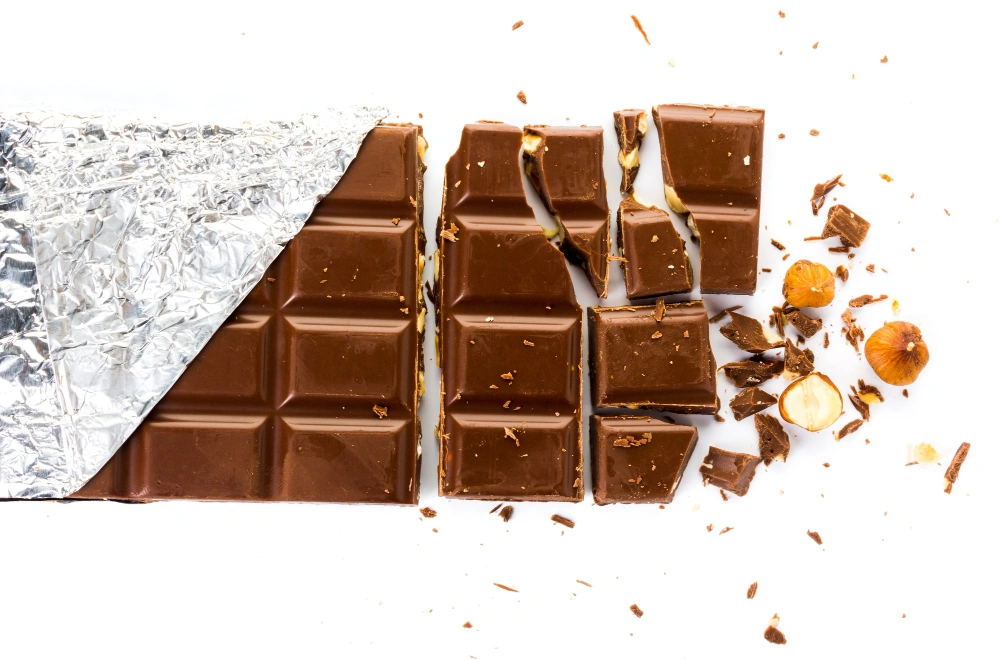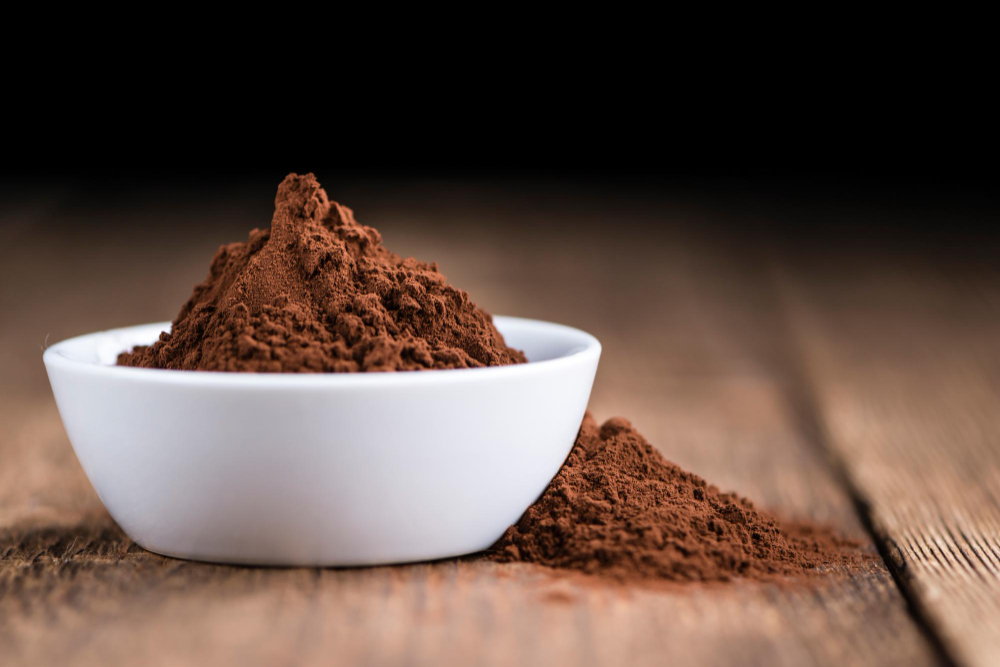Data-Driven Cocoa Powder Alkalization: From Experience to Intelligent Process Control
AI in Cocoa Powder Alkalization marks a transformative step in modern food technology; shifting the traditional alkalization (Dutching) process from experience-based control to intelligent, data-driven optimization.
By integrating machine learning and advanced analytics, AI enables producers to precisely regulate parameters such as pH, temperature and reaction time, achieving superior flavor balance, color uniformity and product consistency.
Recent research demonstrates how AI in Cocoa Powder Alkalization can model the relationships between fat content, amino acids and organic acids to predict their effects on cocoa powder behavior during processing.
For example, a 2024 study by Palma-Morales et al. showed that predictive AI models can reduce certain fatty acid ratios and enhance polyphenol levels, leading to more stable flavors and improved product quality.
By merging chemical insights with AI-based modeling, this intelligent approach reduces energy consumption, enhances reproducibility and ensures a more sustainable, high-precision production process, redefining quality control in the cocoa industry
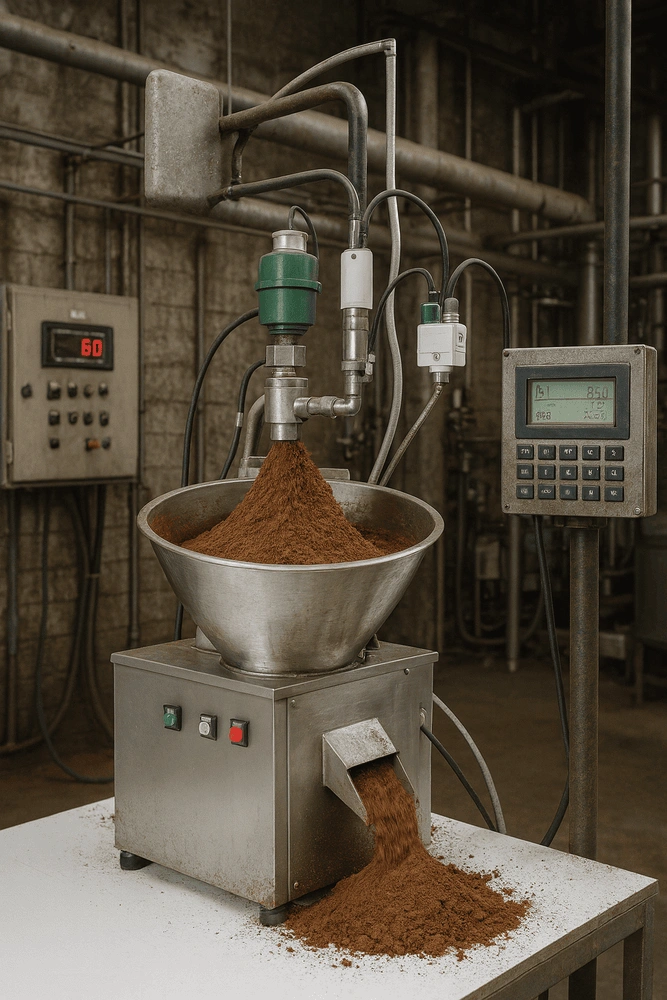
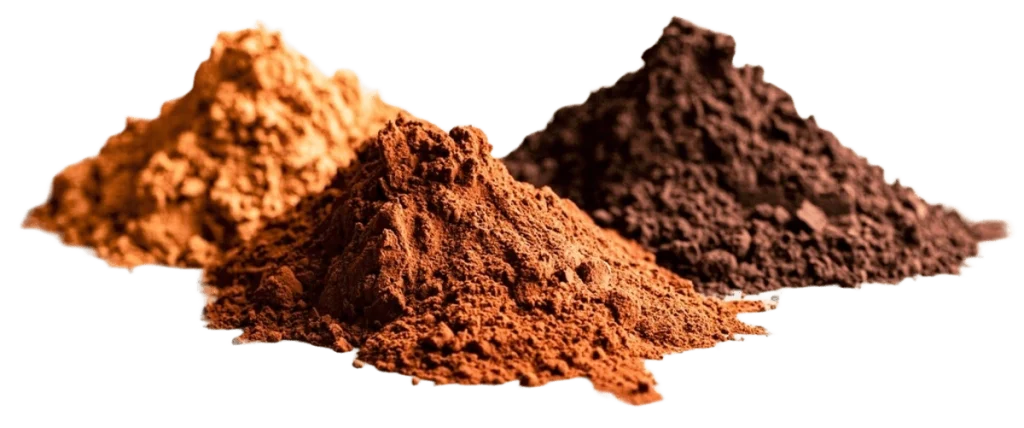
What Is Cocoa Powder Alkalization (Dutching) and Why Does It Matter ?
It is a process that uses alkaline solutions to alter the structure of cocoa, changing its color, flavor and stability This process improves the overall quality of the final product.
To learn how different types of alkalis affect the final product quality, read here.
- Related articles
The Effect of Process Variables on Color, Flavor Stability and Bioactive Compounds
In the cocoa powder alkalization process, four key variables ( temperature, pH, reaction time and type of alkali) have the greatest impact on color, flavor and the stability of bioactive compounds.
As temperature and reaction time increase, alkalization reactions intensify, darkening the color and enhancing flavor; however, if not properly controlled, they can also cause the degradation of polyphenols and aroma compounds.
The type of alkali and the resulting pH also influence salt formation antioxidant activity, and flavor uniformity.
In traditional approaches, controlling these variables precisely is difficult and often depends on operator experience.
By analyzing parameters such as temperature and pH in real time, data-driven systems can optimize conditions and maintain stability more effectively.
As a result, this intelligent control produces cocoa powder with more stable color and flavor, while better preserving valuable bioactive compounds. an outcome that AI in Cocoa Powder Alkalization makes increasingly achievable.
Limitations of Traditional Approaches: Dependence on Experience, Color Variability and Energy Loss
In conventional or pilot-scale cocoa powder alkalization, decision-making is mainly based on operator experience and empirical trials. performing multiple test batches and evaluating results manually.
However, such methods face several limitations :
High sensitivity to human error and environmental conditions
Color variability between batches (some appearing darker or lighter)
Undesirable impact on bioactive compounds such as flavonoids
High energy consumption due to repeated heating and temperature control
Difficulty in scaling up to full industrial production
These constraints make it challenging to maintain consistent color and flavor, ensure antioxidant retention and achieve efficient process control.
That’s why the transition toward AI in Cocoa Powder Alkalization is becoming essential for improving stability, precision and sustainability.
The Need for AI in Cocoa Powder Alkalization : Toward Predictive and Stable Quality
To overcome the challenges of traditional alkalization, the design and control of the process must be based on data-driven intelligence rather than manual experience.
AI in Cocoa Powder Alkalization enables this transformation by analyzing historical process data to identify hidden patterns and relationships among key parameters such as temperature, pH, alkali type and reaction time.
Machine learning models can simulate these interactions, predict optimal process conditions and adjust parameters dynamically for each cocoa batch.
This adaptive approach minimizes quality fluctuations between batches and enables real-time control.
Through adaptive control systems, AI can automatically regulate temperature, pH, and reaction time to stabilize both flavor and color consistency.
Ultimately, combining process knowledge with AI-driven analytics provides a powerful foundation for intelligent, precise, and sustainable cocoa alkalization. ensuring consistent quality and operational efficiency.
واکنشهای کلیدی مؤثر بر رنگ، طعم و ترکیبات زیستفعال
Key Reactions Affecting Color, Flavor, and Bioactive Compounds
During cocoa powder alkalization, several main reaction pathways determine the final sensory and chemical properties of the product :
Salt formation : Neutralization reactions between acidic compounds (citric acid, acetic acid) and alkali agents produce salts that modify pH and ionic strength.
Redox reactions : Oxidation and reduction processes alter polyphenol content, affecting flavor and antioxidant activity.
Complexation reactions: Formation of complexes between metal ions and polyphenols can influence bitterness and color stability.
Structural rearrangements : Rearrangement of molecular bonds (C–O–C, C–C linkages) in the cocoa matrix leads to deeper brown color and improved stability.
Proper control of these reactions is essential to prevent degradation of bioactive compounds and to achieve consistent product quality.
The Role of Analytical Data in Modeling Chemical Behavior
In multivariate processes such as alkalization, the use of chemometrics is crucial: multivariate analysis (PCA, PLS, MCR) can transform complex data into meaningful components and identify hidden patterns.
Analytical data such as UV-Vis, NIR, HPLC, LC–MS, GC–MS spectroscopy are converted as input into data-driven models, allowing the link between process conditions and molecular changes (changes in metabolite profiles).
Chemical Mechanisms and Molecular Changes in the Cocoa Powder Alkalization Process The alkalization of cocoa
powder involves a series of chemical and sensory transformations. At each stage, chemical reactions between natural cocoa components and the added alkali modify molecular structures, affecting color, aroma, and flavor.
Adjusting parameters such as temperature and pH accelerates these reactions. An increase in pH promotes pigment formation, while extended reaction time enhances flavor intensity but may reduce polyphenol content and antioxidant capacity.
These molecular changes ultimately shape the color and quality of cocoa powder. Understanding the chemical pathways and their interactions helps optimize conditions for desired color tones, flavor balance, and bioactive compound retention.
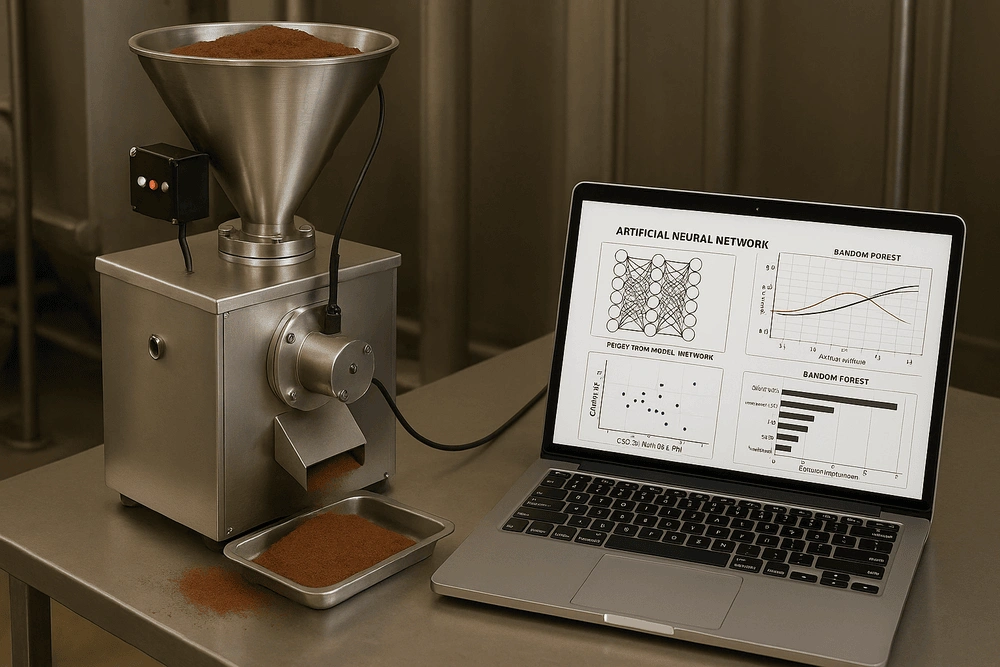
Modeling the Relationships Among pH, Temperature, Time and Product Quality
Cocoa powder alkalization exhibits nonlinear relationships between key process parameters ( such as pH, reaction time, alkali type, and concentration ) and product quality indicators like color intensity, flavor balance, and antioxidant capacity.
Machine learning techniques are increasingly applied in this field.
For instance, studies indexed in PubMed and Annual Reviews have shown that Random Forest models can accurately predict the effects of reaction variables on cocoa flavor profiles and quality outcomes.
These models analyze multivariate datasets to reveal how combinations of factors ( temperature × pH × time , … ) influence sensory characteristics.
Such predictive modeling provides a data-driven foundation for intelligent process control and real-time optimization in modern cocoa processing.
Intelligent and Adaptive Control of the Alkalization Process
By leveraging large datasets from sensors measuring pH, NIR and temperature, smart control systems can continuously monitor and adjust processing conditions.
Through Adaptive Control and Digital Twin frameworks, the system can simulate actual chemical and physical conditions, predict potential deviations, and apply corrective actions automatically.
Advanced methods such as Reinforcement Learning and Bayesian Optimization further refine this process, reducing human intervention and enhancing decision precision.
The result is a self-optimizing control architecture capable of maintaining consistent color, flavor, and stability ( as already implemented in leading industrial systems .
Ultimately, combining AI in Cocoa Powder Alkalization with adaptive learning systems transforms traditional cocoa processing into a predictive, efficient and sustainable operation.
Data-Driven Modeling and Machine Learning in AI-Based Cocoa Powder Alkalization
The cocoa powder alkalization process involves complex, nonlinear interactions among temperature, pH and reaction time.
AI in Cocoa Powder Alkalization enables the identification of hidden patterns linking these parameters to final product attributes such as color, flavor and stability.
Machine learning models analyze extensive process data to predict and optimize product quality outcomes.
Algorithms such as Decision Trees, Random Forests and Artificial Neural Networks (ANNs) can model the relationships between physicochemical variables and sensory features of cocoa powder.
Using NIR, pH and temperature data, these models can predict changes in real time, recommend process adjustments and continuously enhance performance through feedback-based learning.
This approach allows dynamic control, ensuring flavor stability and consistent product quality across batches.
Molecular Analysis of Cocoa Powder Alkalization: From Data to Chemical Insight Beyond its visible effects on
color and flavor, the alkalization process induces complex molecular transformations that alter the structure and bioactive composition of cocoa powder.
Studies using LC–MS/MS metabolomics and Feature-Based Molecular Networking (FBMN) have shown a reduction in certain polyphenolic compounds, along with shifts in fatty acid derivatives and other bioactive metabolites.
These molecular network changes reveal extensive structural rearrangements that can be visualized through chemical mapping.
By integrating process data (temperature, pH, time) with AI in Cocoa Powder Alkalization, researchers can better understand the relationships between reaction conditions and product quality.
When combined with chemometric modeling, this analytical integration enables precise prediction of how process parameters affect flavor, color, and antioxidant stability.
Ultimately, cocoa powder alkalization evolves from an empirical operation into a data-driven, predictive, and chemically informed process, improving both product quality and sustainability.
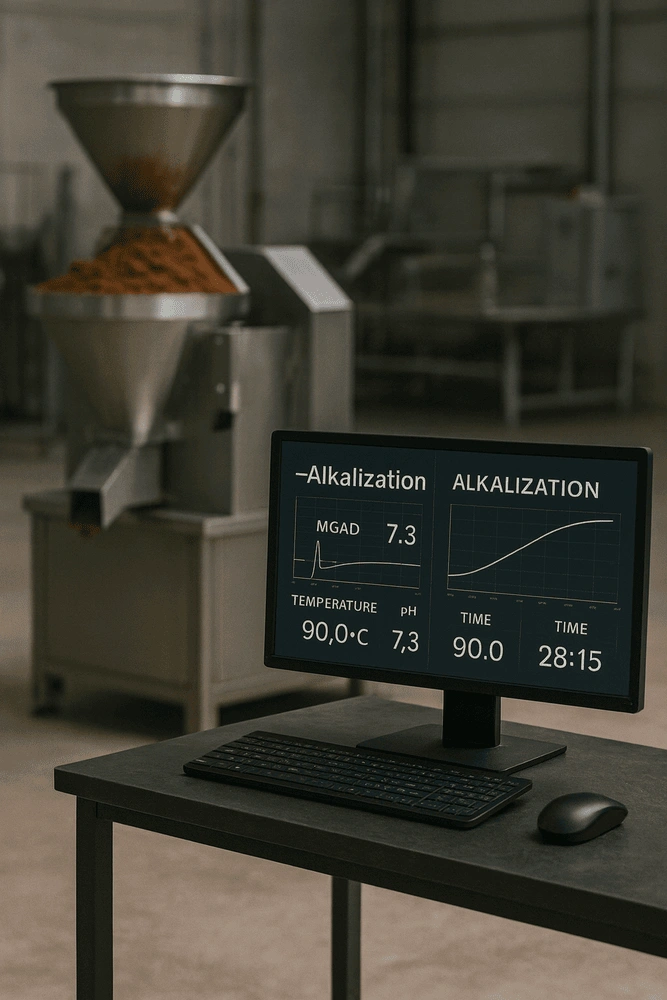
Hybrid Data-Driven and Physical Models in Cocoa Powder Alkalization
In the cocoa powder alkalization process, AI in Cocoa Powder Alkalization leverages hybrid modeling approaches to combine data-driven machine learning with physical process understanding.
These Hybrid Models integrate analytical data on parameters such as pH, temperature, and reaction time with physicochemical equations to describe and predict process behavior under varying conditions.
Physical sub-models explain how and why molecular and chemical reactions evolve, while the data-driven layer (using regression or neural networks) refines these predictions through empirical learning.
This combination enhances accuracy, reduces calibration effort, and provides real-time adaptability in dynamic production environments.
In industrial applications, hybrid models integrate with NIR, pH, and temperature sensors to continuously collect process data.
They can update parameters automatically and recommend optimal reaction paths. allowing operators to monitor and adjust the process while maintaining consistent color, flavor, and bioactive compound stability.
Vision-Based Monitoring and Intelligent Quality Control
One of the most advanced applications of hybrid modeling in cocoa processing is vision-based monitoring, used for intelligent quality control.
In this approach, visual data from production lines are analyzed using Convolutional Neural Networks (CNNs) to assess color uniformity, particle distribution, and surface texture of cocoa powder in real time.
These AI-driven imaging systems can replace or supplement human sensory evaluations, providing continuous and objective quality monitoring.
Studies have shown that combining spectral data (e.g., NIR imaging) with visual analytics enhances prediction accuracy for flavor consistency and overall product quality.
By integrating vision-based AI with hybrid control systems, manufacturers achieve higher precision, reduced energy consumption, and consistent batch-to-batch quality; setting a new benchmark for smart cocoa processing.








